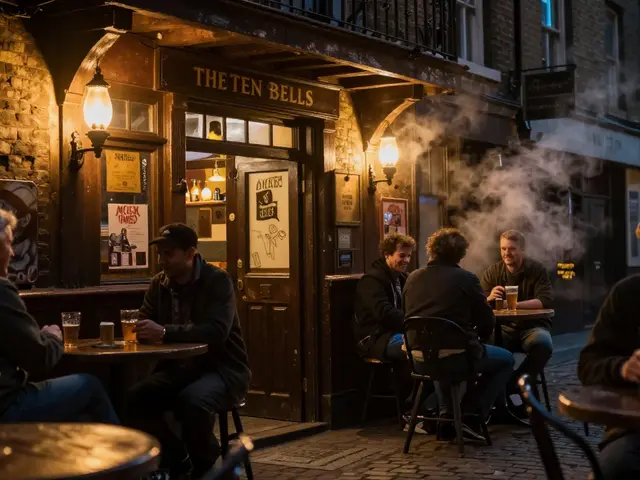Back in the 1870s, a woman walking alone in Mayfair after dark wasn’t just unusual-she was suspicious. But if you knew where to look, you’d find quiet townhouses with discreet brass doorbells and curtains drawn just enough to let the right people in. These weren’t brothels. They weren’t saloons. They were the first real escort services in London, and they operated under the thin veil of companionship.
There was no app. No website. No Instagram profile. Just word of mouth, trusted intermediaries, and cash paid in envelopes. The women who worked these roles weren’t called escorts-they were called ‘ladies of society,’ ‘companions,’ or sometimes, in hushed tones, ‘kept women.’ Many were widows, daughters of fallen aristocrats, or women who’d been cast out of respectable life. They didn’t advertise. They didn’t need to. Their clients were judges, bankers, colonial officers, and even a few MPs who knew better than to be seen.
The Rise of the Private Companion
By the early 1900s, London’s escort scene had shifted from hidden parlors to more formalized arrangements. The term ‘companion’ became the legal shield. A woman could be hired to attend the opera, travel abroad, or simply sit at dinner and hold conversation. The line between sex and companionship was blurry, but legally, it mattered. If a woman could prove she was paid for conversation, not physical intimacy, she avoided prosecution under the Contagious Diseases Acts or later, the Street Offences Act of 1959.
One of the most famous cases was that of Mabel Sutherland, a former debutante turned companion who worked for a London agency called The Athenaeum Society. She kept detailed diaries-later published in 1982-that revealed clients paid £50 a night (roughly £6,000 today) for her company. She never slept with them, she claimed. But her clients didn’t care. They wanted someone who knew how to quote Byron, how to order champagne without flinching, and how to disappear quietly after midnight.
Post-War Decline and Underground Resurgence
After World War II, London’s escort scene went quiet. The moral panic of the 1950s, fueled by tabloids and religious groups, pushed most operations underground. The Wolfenden Report of 1957 recommended decriminalizing private homosexual acts and prostitution between consenting adults-but it took until 1981 for any real change to take hold.
By the 1970s, a new kind of escort emerged: the independent woman. No agencies. No madams. Just classified ads in the back of Time Out magazine. A photo. A phone number. A price list: £25 for an hour, £75 for the night. These women were often students, single mothers, or artists. They worked out of flats in Notting Hill, Camden, or Bayswater. They didn’t wear gowns. They wore jeans. And they were the first to openly say: ‘I’m not a prostitute. I’m an escort.’
The difference wasn’t just semantics. It was control. These women set their own hours, chose their clients, and kept 100% of their earnings. No one took a cut. No one told them what to wear. And when the police raided a flat in 1984, the woman inside didn’t cry. She handed them her tax return.
The Internet Changed Everything
By 2005, Google had replaced classified ads. Websites like LondonLadies.com and EliteEscorts.co.uk popped up overnight. Suddenly, anyone with a decent camera and a bank account could become an escort. The market exploded. By 2010, over 12,000 women in Greater London were listed on escort sites. That’s more than the number of licensed taxi drivers.
But this wasn’t just about numbers. It was about branding. Escorts started building websites like boutique businesses. They wrote blogs. They posted photos of their favorite cafes. They listed their hobbies: ‘I love vintage vinyl,’ ‘I’m learning Mandarin,’ ‘I hike in Epping Forest on weekends.’ They weren’t just selling time-they were selling a lifestyle. And clients started paying for that.
A 2018 survey by the London School of Economics found that 68% of clients chose their escort based on personality, not appearance. One client, a 52-year-old tech executive, told the researchers: ‘I don’t want someone who looks like a model. I want someone who can talk about quantum computing, argue about Brexit, and then make me tea like my mum used to.’

Modern London Escorts: Businesswomen First
Today, the average London escort is 31 years old. She has a university degree. She pays her own taxes. She uses accounting software to track income and expenses. She’s covered by private health insurance. She books appointments through Calendly. She uses Stripe for payments. And she rarely works the streets.
Many now run their own agencies-small, legal, and professional. Some focus on high-end clients. Others specialize in LGBTQ+ companionship. A few even offer ‘emotional support’ packages, where clients pay for a two-hour conversation after a breakup or a loss. These aren’t therapy sessions. But they’re not just sex, either.
In 2023, the UK government quietly updated its guidance on escort services. It no longer classifies them as ‘prostitution’ if no sexual act occurs. That’s a huge shift. It means escorts can now legally advertise their services as ‘companionship’ without fear of arrest. It also means they can open bank accounts, apply for loans, and even get mortgages-something unthinkable just 15 years ago.
What’s Different Now?
Here’s what’s changed since the 1800s:
- Control: Women now control their own business. No pimps. No agencies taking 50%.
- Legality: As long as no money changes hands for sex, it’s not illegal. Many escorts work in a legal gray area-and they’re careful about it.
- Technology: Apps, encrypted messaging, and digital payments mean safety and anonymity are built into the system.
- Perception: Clients aren’t just wealthy men anymore. They’re single women, older men, international travelers, even people with autism who struggle with social interaction.
There’s still stigma. There are still bad actors. But the industry isn’t what it used to be. It’s not about desperation. It’s about choice.

Common Myths About London Escorts Today
Let’s clear up a few misunderstandings:
- Myth: All escorts are exploited. Reality: A 2024 study by the University of Bristol found that 79% of London escorts reported high levels of autonomy and job satisfaction.
- Myth: They’re all young and beautiful. Reality: The average age is 31. Many are in their 40s and 50s. Experience matters more than looks.
- Myth: They’re all from Eastern Europe. Reality: Over 60% are British-born. The rest come from all over the world-Canada, Australia, South Africa, Brazil.
- Myth: It’s dangerous. Reality: Most use verified client screening tools. Many require ID, video calls before meetings, and never meet alone in unfamiliar locations.
What’s Next?
The next big shift? Integration with mental health services. Some agencies are now partnering with licensed counselors to offer clients a ‘companion + session’ package. It’s not therapy. But it’s not just sex either. It’s human connection, paid for, on demand.
And as AI companions become more common, real human escorts are doubling down on what machines can’t replicate: emotional intelligence, spontaneity, and the quiet understanding that comes from being truly seen.
London’s escort industry didn’t disappear. It evolved. From hidden rooms to digital profiles. From shame to self-ownership. From silence to strategy.
It’s no longer about who you’re sleeping with. It’s about who you’re spending time with-and why.
Is it legal to hire an escort in London today?
Yes, as long as no money is exchanged for sexual acts. Companionship-dinner, conversation, travel, or even just sitting together-is legal. The law only criminalizes prostitution, which is defined as exchanging sex for payment. Many escorts operate in a legal gray zone by clearly separating paid companionship from sexual activity. They often use contracts, verbal agreements, and client screening to stay on the right side of the law.
How do modern London escorts screen clients?
Most use a multi-step process. First, they require a video call before any meeting. Second, they ask for a government-issued ID. Third, they use apps like SafeDate or EscortShield to verify client history. Many also require payment upfront via Stripe or PayPal to avoid cash scams. Some agencies even run background checks through third-party services. The goal isn’t to be suspicious-it’s to be safe.
Are most London escorts women?
The vast majority are women, but the number of male and non-binary escorts has grown significantly since 2020. A 2024 industry report showed that 18% of listings on major platforms are male or gender-diverse. Demand is rising, especially among LGBTQ+ clients and older men who prefer non-traditional companionship. The industry is slowly becoming more inclusive.
Do escorts in London pay taxes?
Yes, and many do so voluntarily. Since 2018, HMRC has encouraged self-employed escorts to register as sole traders. Over 40% now file annual tax returns. They deduct expenses like travel, clothing, phone bills, and website hosting. Some even hire accountants. The stigma around declaring income is fading, especially as more escorts build long-term careers and seek mortgages or business loans.
Why do people hire escorts in London today?
It’s not just for sex. Many hire escorts for companionship-someone to travel with, talk to after a long week, or attend a wedding with. Others seek emotional support during divorce, grief, or loneliness. A 2023 survey found that 62% of clients said they hired an escort because they felt isolated. The service fills a gap that friends, family, or therapists sometimes can’t. It’s about human connection, not just physical intimacy.







Write a comment